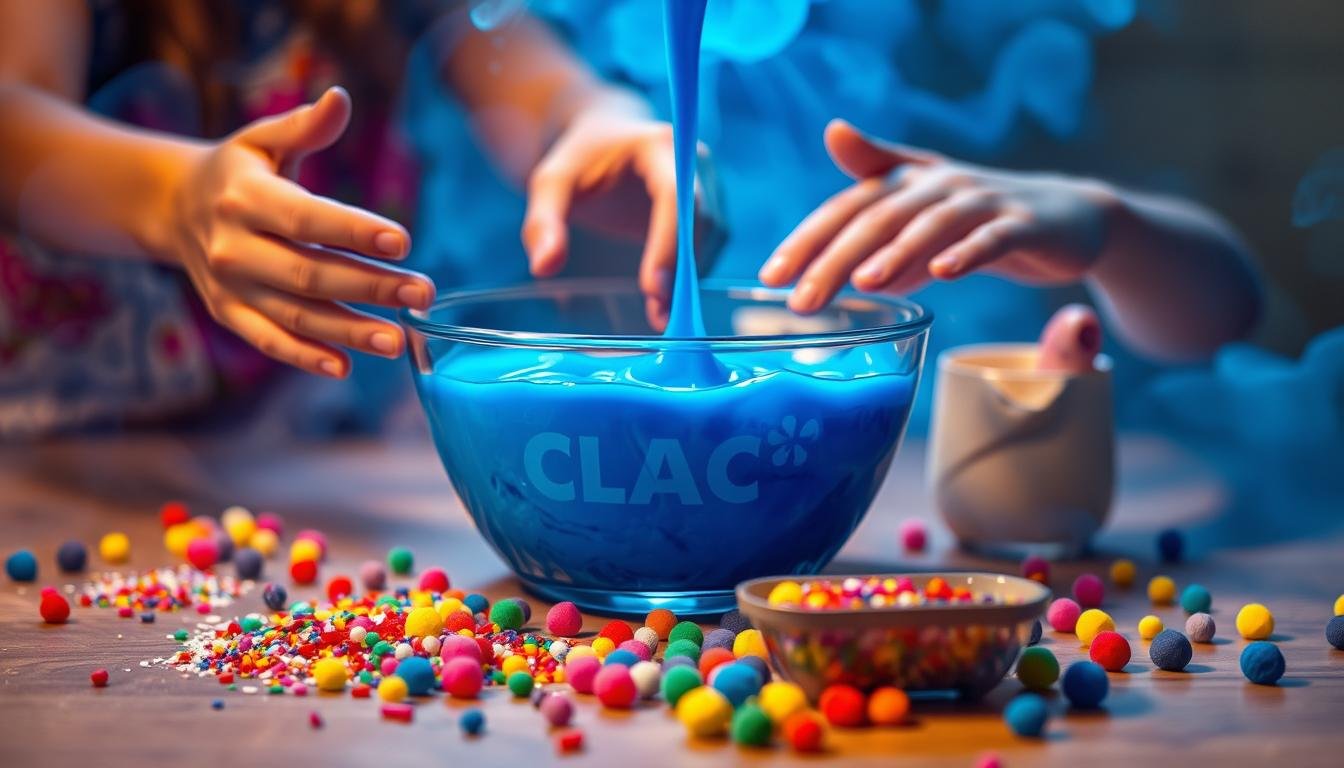With over 700,000 reads on our slime-making guides, it’s no secret that concocting homemade slime has captured the hearts and hands of the UK’s youth. As a dedicated author in the editorial team of CSAC.org.uk, I’m here to guide you through a squishy journey of sensational sensory play, minus the typical chemical activators. Our attention is turned toward crafting delightfully gooey DIY slime using simple household staples such as shampoo, baking soda, and contact lens solution.
Conventional activators have raised eyebrows due to health concerns, but our easy slime recipes promise the same pliable pleasure without compromising safety or fun. With just a few common ingredients—each with a specific role in achieving that perfect, dough-like fluffy consistency—preparing homemade slime becomes not only effortless but also a creative catalyst for fine motor skills development.
Bypass the Borax and join me in exploring the imaginative realm where everyday items transform into hours of tactile amusement. Trust me, the mere cost of about $1 and the satisfaction of watching little ones delight in their vibrant creations is worth every stretch, pull, and squish of your lovingly-crafted, activator-free slime.
Introduction to Easy Slime Making
Slime making for beginners is not just a craze, it’s a creative and educative pursuit that combines the joy of children’s crafts with the excitement of fun home activities. This simple activity not only captivates the children’s imagination but also facilitates a hands-on learning experience in basic chemistry and physics without the need for hazardous materials, promoting activator-free slime making methods.
Using everyday household items such as PVA glue, baking soda, and saline solution, anyone can start their journey into the engrossing world of slime making. Slime making for beginners allows children and adults alike to explore their artistic side by creating diverse textures and colours of slime, in a safe, borax-free environment. The immense popularity of this craft is largely influenced by online communities and DIY tutorials that make learning both accessible and enjoyable.
The following table outlines the basic requirements and some fun variations to get started with your own slime creation:
| Ingredient | Quantity | Function | Optional Variations |
|---|---|---|---|
| PVA Glue | 1 cup | Base of the slime | Glitter, food colouring |
| Baking Soda | 1 teaspoon | Thickener | – |
| Contact Lens Solution | 1 tablespoon | Activator (must contain boric acid) | – |
Slime is not only an excellent tool for sensory play but also enhances fine motor skills as children knead and stretch their creations. Engaging in fun home activities like slime making also provides a platform for youngsters to learn measurement and proportion, crucial skills in both academic and real-world scenarios.
The ease of making slime at home also means countless hours of affordable entertainment that can be continually modified for never-ending fun. Whether it’s mixing in sequins for a sparkling texture or using different colours for a vibrant visual effect, slime can be tailored to fit any child’s aesthetic preference. As a safe, cost-effective, and highly adaptable form of children’s crafts, slime making is an enriching activity that should undoubtedly be encouraged at home.
Understanding the Basics of Slime
Exploring the secrets behind slime science helps us appreciate why this sticky, gooey substance is more than just a plaything. Slime making is a popular activity that combines both entertainment and education, demonstrating fundamental principles of chemistry. Whether it’s creating a batch of activator-free, child-friendly slime or exploring various activator substitutes, understanding these bases contributes effectively to safer and more enjoyable experiences.
The appeal of creating slime without traditional activators like borax lies in the safety and accessibility of using more common household items. These activator substitutes often include ingredients like baking soda and contact lens solution, making slime a child-friendly activity. This shift not only addresses safety concerns but also enhances the educational value of slime making, inviting young minds to innovate with available materials.
Moreover, slime is classified as a Non-Newtonian compound, exhibiting unique behaviors not typical of standard liquids or solids. This fascinating characteristic is largely due to the interactions between the slime’s components, primarily glue and the various substitutes used as activators.
What Makes Slime Work Without Activator
Typically, the ‘activator’ in slime recipes refers to substances that induce a chemical reaction causing the slime to thicken and behave as it does. When using common household products like baking soda and contact lens solution, which contains boric acid, a similar reaction is promoted. These react with polyvinyl alcohol (PVA) found in glue, facilitating a transformation into the playful substance known universally as slime.
Difference Between Activator-Based and Activator-Free Slime
Activator-based slimes tend to have a smoother, more uniform consistency compared to their activator-free counterparts. The latter might exhibit varied textures, from slightly grainy to a dough-like feel, depending on the mixture and proportions used. This difference in texture highlights the adaptable nature of slime science, allowing for numerous variations tailored to the creator’s preference or safety requirements.

When considering child safety and ease of creation, many parents and educators opt for activator-free recipes. These not only mitigate potential risks associated with certain chemicals but also offer a more tactile and involved experience for children.
| Ingredient | Standard Ratio | Alternative for Different Textures |
|---|---|---|
| Baking Soda | 1/2 teaspoon | 1 tablespoon for sand slime |
| Contact Lens Solution | 1½ tablespoons | 5-10 mL extra for better results |
| Glue (Standard Slime) | 4-6 ounces | 2:1 ratio to activator for optimal slime |
| Water (for dissolving baking soda) | 1 cup | Use hot water for glitter glue slime |
Understanding these basic elements and their interactions empowers us to create an array of slime types, each with its own unique characteristics, while fostering a safe and educational environment around an activity beloved by many.
How to Make Slime Without Activator
Following easy slime instructions can help you create fun, safe slime making at home without the need for traditional activators like Borax. The process is ideal for people seeking non-toxic alternatives and was clearly highlighted by recent data showing 166 people searching specifically for “Make Slime Without Activator”. This significant interest aligns with the growing trend towards using everyday household ingredients for crafting activities.
The most popular no-activator slime recipe incorporates contact lens solution that contains boric acid. Although this may sound like an activator, it is much milder and safer, particularly for children’s activities, hence its inclusion in over 15 kid-friendly recipes. Combining this with classic PVA glue and a pinch of baking soda creates a malleable and stretchy mixture. Adding elements like colouring or glitter renders the slime more appealing while maintaining its non-toxic nature.

To illustrate, the following table summarises ingredients and time required for crafting a non-toxic fluffy slime:
| Ingredient | Quantity Needed | Purpose |
|---|---|---|
| Elmer’s white school glue | 4 ounces | Base material |
| Contact lens solution | 2-3 tablespoons | Bonding agent (contains boric acid) |
| Unscented shaving cream | 1.5 cups (average) | To create fluffy texture |
Additionally, statistics confirm the wide variety found in DIY slime recipes suitable for a no-activator approach. Among them, fluffy, cloud, and conditioner slimes stand out, with each type providing distinct properties and sensory experiences for children, which is crucial in early childhood development.
For parents, the quick 5-minute preparation time is particularly appealing. It allows for an engaging and educational pastime that doesn’t demand extensive planning or supervision. The simplicity and safety of the slime recipe guarantee hours of safe play, illustrating why this method has become a staple in homes across the United Kingdom.
- Simple and quick to prepare
- Safe with nontoxic components
- Enhances sensory and educational experiences
These user-friendly, safe slime making practices are transforming the way we approach DIY crafts at home, making them accessible and enjoyable for the entire family whilst ensuring safety and creativity go hand-in-hand.
Favourite Slime Recipes Without Activator
For many families in the United Kingdom, creating safe kids’ crafts at home has become a delightful pastime. Among these, homemade fluffy slime and stretchy slime recipes stand tall as favourites, requiring minimal, common household ingredients. Both recipes offer a creative and less-toxic alternative to commercially available slimes, and with this guide, you will be well-equipped to craft your very own batches of these squishy delights.
Fluffy Slime with Shampoo and Cornstarch
Making fluffy slime is incredibly easy and fast. With just a 3/4 cup of Elmer’s white school glue, 1/4 cup of water and a generous addition of 3 cups of shaving cream, you’re on your way to crafting the fluffiest concoction. To achieve the perfect blend, 1/2 teaspoon of baking soda is included, and for vibrancy, a teaspoon of acrylic paint offers a more colourfast option compared to food colouring. The mixture is then activated with 2 tablespoons of contact lens solution containing the critical boric acid and sodium borate. Within less than 10 minutes, your fluffy slime will come alive, retaining its unique texture for a day, and if kept in an airtight container, it will entertain for at least a week.
Stretchy Slime with Baking Soda and Contact Lens Solution
For a stretchy slime recipe, start with half a cup of Elmer’s White School Glue known for its dependable performance in slime creations. An exact mixture of 1/2 teaspoon of baking soda and 1/3 cup of water forms the base. Should you wish to add colour to your creation, 10 drops of liquid food colouring will suffice. The secret to the stretchy texture lies in the addition of 2-3 tablespoons of contact lens solution — prices for which, at a pharmacy, can range from £4 to £15. However, ensure the solution has boric acid, without which the slime won’t set. Stirring the concoction results in a non-sticky, malleable slime that can be played with repeatedly. If stickiness persists, adding more contact lens solution in small increments is the key, while a tad bit of warm water can soften it if it’s too stiff.












